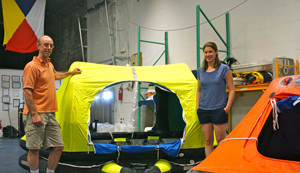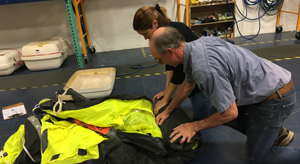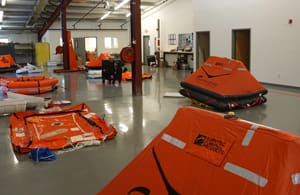Jon Leavitt lifted the life raft onto the workshop floor and opened its fiberglass case. He quickly found water where it didn’t belong.
Liquid had pooled at the bottom of the case. Leavitt sliced into the vacuum bag and removed this protective outer layer surrounding the raft. Again, he noticed water, this time on the raft itself.
“A little bit of moisture has gotten in. You can see rust on the fittings,” he said, pointing to metal components connecting the carbon dioxide canister to the raft. “I don’t know how the moisture got in, but it did.”
He figured it out minutes later: A tiny hole opened in the vacuum bag, likely from rubbing against the gas canister during years at sea.
Leavitt, whose family has run Chase Leavitt & Co. in Portland, Maine, for more than 150 years, has serviced life rafts since the mid-1980s. In a given year, the company repacks about 650 rafts, many for lobstermen and fishermen operating from nearby ports.
 |
|
Jon Leavitt of Chase Leavitt in Portland, Maine, unpacks a raft for inspection. |
Chase Leavitt, along with its other facility in Ellsworth, Maine, is among a handful of companies performing this work. Liferaft Services, with stations in York and Belfast, Maine, is another. But there are fewer than 10 such facilities between Canada and Boston.
Authorization required
The Coast Guard and life raft makers won’t let just anyone service a raft. Approved operations must pass a Coast Guard inspection and receive authorization from the manufacturers. This authorization typically requires employees to complete a training program, among other steps. Kent Molsted Jorgensen, Viking’s manager for rules and regulations, said the company has a “zero-tolerance policy” toward unauthorized servicers.
Why so much scrutiny? Jorgensen cited several reasons. For one, life rafts are critically important safety devices that must work during emergencies. Secondly, different raft types are serviced differently, and technicians must be familiar with each.
“This is not a process put in place by manufacturers to complicate things,” Jorgensen, who is based in Denmark, said by email.
Rather, he continued, the process ensures life rafts dropped at authorized stations are properly inspected, serviced, repaired and packed before being returned to the customer. This ensures the raft “will function if needed until the next date of servicing.”
 |
|
Sales manager Eric LaRose, left, with technician Tim Virgin of Liferaft Services alongside a raft prior to repacking. |
Under federal rules, commercial fishermen and inspected vessel operators must carry life rafts and service them annually. There are no such requirements for recreational vessels, although some regattas and offshore races require life rafts.
“While we would recommend servicing recreational life rafts at the required intervals, it is not required by regulation to be done,” said Kevin Plowman, USCG Sector Northern New England Commercial Fishing Vessel Safety Examiner.
Viking, Survitec and other major raft makers typically recommend servicing every three years for rafts packed in vacuum-sealed bags. There are no statistics showing how many recreational owners follow these guidelines, but raft makers and servicers acknowledge some owners don’t follow them.
“Most people do not repack their rafts, or do it in a timely manner,” said Andy Hiller, a sales manager with safety gear maker Survitec Group.
Hiller suggested one reason is an “out of sight, out of mind” mentality, particularly for raft owners who store them below deck. Cost is another factor. Although life raft servicing typically ranges from $500 to $1,000, standard recreational four- to six-person raft servicing can be found for $1,200 or less.
Regular service extends life
On the other hand, regularly serviced rafts can last 15 or 20 years. But for boaters not inclined to service their rafts, delaying the work doesn’t typically save money, according to Eric LaRose, sales director with Liferaft Services. Food, water, batteries and flares inside the raft have varying expiration dates, and pushing off service means more of these items must be replaced. At some point, repairs might also become necessary.
 |
|
Jon Leavitt and technician Nicole Walsh work on a raft, above and below. |
“Instead of deferring that cost over two repacks, you’re doing it during one and everything has to be done to the raft,” LaRose said in a recent interview.
Will life rafts not serviced regularly work during an emergency? Probably, although manufacturers and services don’t recommend the risk. Water ingress can cause mold, rust and other damage. LaRose likened long-unserviced rafts to lottery tickets. “You’re giving yourself a chance,” he said, “but maybe not the best chance.”
Back in Chase Leavitt’s 2,900-square-foot servicing bay, Jon Leavitt continued work on the eight-person Viking RescYou raft. Chase Leavitt sold the self-righting raft four years earlier to a sailing customer. This was its first service.
After removing it from the case, Leavitt unhooked the painter line connected to a cable on the carbon dioxide cylinder. He sliced into the silver vacuum bag and determined the raft was in decent shape — despite modest water intrusion.
Leavitt removed the vacuum bag and went to work disconnecting the carbon dioxide canister, which refused to budge. When activated, this gas can inflates the raft, usually within about eight seconds. Leavitt experimented with different tools and positions but couldn’t pry it loose from the rusted fittings.
He retrieved a rubber mallet and specialized wrenches from a dedicated tool wall. Five minutes later, the can was free. “I’ve never had one of these that didn’t come off,” Leavitt said. With a smile, he added, “This is why people should bring their rafts in on time.”
 |
Technician Nicole Walsh assisted with the servicing. After unfolding the raft, she laid it on the workshop floor, connected a hose and inflated its internal chambers. The raft popped, squeaked and groaned as its rubber fabric separated.
Once inflated, Walsh took a series of readings to test its airtight integrity. Next, she removed the raft’s equipment pack and separated expired items, including batteries and both hand-held and parachute flares.
Expired flares are a headache for most boaters, but they’re a special challenge for raft servicers. Chase Leavitt takes in thousands of unused but likely still potent flares a year. Leavitt solves this problem by driving batches of flares to a New Jersey fireworks company.
If all goes well, raft servicing takes the better part of a day. The Viking raft required repairs to the emergency light system, among other components, which extended the job. In the meantime, Leavitt replaced the rusted hose and metal fittings while Walsh re-stocked the equipment bag.
After comparing the various readings with Viking standards, the pair determined the raft passed inspection. Only about 5 percent ever fail, and they’re usually older with obvious issues. Walsh attached a hose and went to work removing air to begin the repacking.
 |
|
Leavitt and Walsh service rafts for both commercial and recreational vessels. |
Repacking challenges
Recreational life rafts are designed to use as little space as possible. But small containers create challenges during the repack. Servicers must follow precise packing instructions so rafts will inflate during emergencies — and fit in their cases.
Walsh and Leavitt kneeled beside the deflated raft and began folding and rolling it into position. After bundling it together, Leavitt sensed something was wrong — the raft appeared too long for its case. He added some air, repositioned some folds and then with a special adapter sucked the air back out.
The pair re-rolled and folded the raft into position, then secured its straps designed to tear away when deployed. Finally, they placed the raft inside a vacuum bag and hot-sealed the bag’s edges. With the bag sealed, they removed excess air and used ratchet straps to compress the raft further.
At this stage, rafts are heavy and dense. If it won’t fit in the case, the process must begin anew. But for Leavitt and Walsh, the second try was spot-on: The raft fit with room to spare. The final repacking took about 75 minutes — longer than usual.
Leavitt acknowledged the raft was a struggle. “With that particular one there was lot of fabric,” he said afterward. “It was a pretty sizable raft from a small container. But we finally got it in there.”
Casey Conley is editor of American Tugboat Review.

